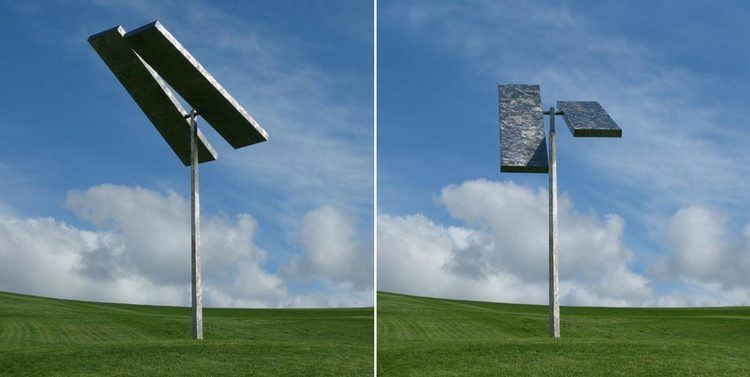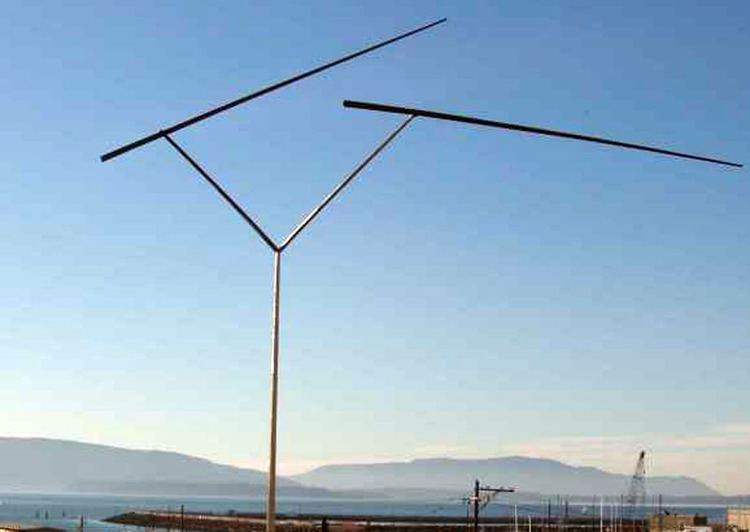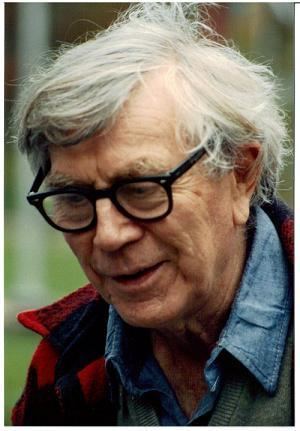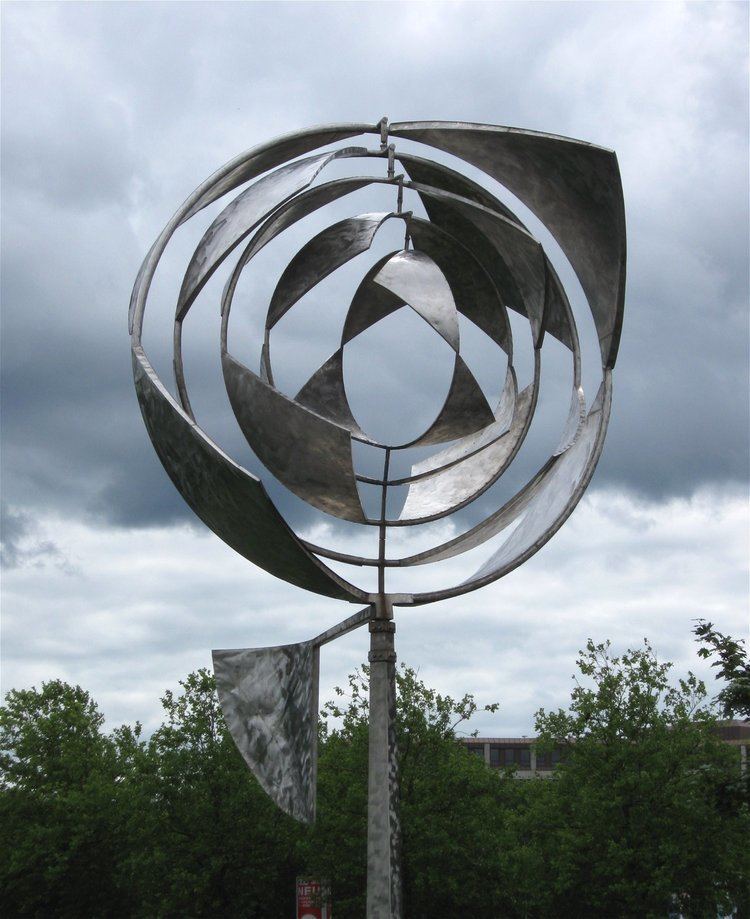Nationality American | Name George Rickey Known for Sculpture | |
 | ||
Artwork Two Lines Oblique Down, Variation III Awards Guggenheim Fellowship for Creative Arts, US & Canada | ||
George rickey beatrixpark schiedam
George Warren Rickey (June 6, 1907 – July 17, 2002) was an American kinetic sculptor.
Contents
- George rickey beatrixpark schiedam
- George rickey binnenwegplein rotterdam
- Early life and education
- Kinetic sculpture
- Honors and awards
- References

George rickey binnenwegplein rotterdam
Early life and education

Rickey was born on June 6, 1907 in South Bend, Indiana. At a 1985 retrospective show, he later recalled that as a very small child, he was fascinated by the window latches in his home. These latches, which can be found in many historic South Bend homes, operate conically at counter-intuitive angles that are oblique to the "apparent" design of the otherwise rectilinear form of the latch. "One expects the latch to open by pulling, but it's a conical crank, you see." This conical, oblique design shows up in many of George Rickey's works, where the axes of motion give unexpected movement to the rectilinear forms of his work.

When Rickey was still a child, his father, an executive with Singer Sewing Machine Company, moved the family to Glasgow, Scotland in 1913. They lived near the river Clyde, and George learned to sail around the outer islands on the family's 30 feet (9.1 m) sailboat.

Rickey was educated at Glenalmond College and received a degree in History from Balliol College, Oxford, with frequent visits to the Ruskin School of Drawing. He spent a short time traveling Europe and, against the advice of his father, studied art in Paris at Académie L’Hote and Académie Moderne. He then returned to the United States and began teaching at the Groton School, where among his many students was future National Security Advisor McGeorge Bundy.
After leaving Groton, Rickey worked at various schools throughout the country as part of the Carnegie Corporation Visiting Artists/Artists in Residence program (partially funded by the Works Progress Administration). His focus was primarily on painting. While taking part in these programs, he painted portraits, taught classes, and created a set of murals at Knox College, Galesburg, Illinois. He maintained an art studio in New York from 1934 to 1942, when he was drafted.
Rickey’s interest in things mechanical re-awakened during his wartime work in aircraft and gunnery systems research and maintenance. Following his discharge, he studied art at the New York University Institute of Fine Arts and later at the Chicago Institute of Design, funded by the G.I. Bill. He taught art at variety of colleges, including Muhlenberg College. While at Muhlenberg, he was commissioned by J. I. Rodale to illustrate an edition of Anton Chekhov's The Beggar and Other Tales. Rickey later moved on to Indiana University South Bend. There, he encountered and was inspired by the work of David Smith.
Kinetic sculpture
Rickey turned from painting to creating kinetic sculpture. Rickey combined his love of engineering and mechanics by designing sculptures whose metal parts moved in response to the slightest air currents.
His first sculpture was shown in New York in 1951 at the Metropolitan Museum of Art group show American Sculpture 1951. The Museum of Modern Art, in New York purchased his seminal Two Lines Temporal I, after Alfred Barr, MOMA’s then Director, had seen it at the exhibition Documenta III in Kassel, Germany.
Rickey’s sculptures can now be seen in major museums in the US and in most European capitals, Japan, and New Zealand. Rickey’s work is often compared to the mobiles of Alexander Calder, but while Calder used organic, playful forms, Rickey’s European lineage is more closely related to the Constructivist principles of geometric engineering. In 1967, Rickey wrote Constructivism – origins and evolution, published by George Braziller, Inc., New York.
In works such as Two Open Triangles Up Gyratory, Rickey's two wind driven elements (engineered to withstand winds of 80 miles per hour (130 km/h)) provide an endless series of combined, almost dance like, shapes and movements.
Rickey mastered not only ordered predictable movements, but also mastered methods of controlling both the speed and tempo of similar objects to respond more randomly, such as in his work Four Open Rectangles Diagonal Jointed Gyratory V.
Much of his work was created in his studio in East Chatham, New York, where he moved after taking a position as a professor of art (sculpture) at Rensselaer Polytechnic Institute in Troy, New York. His kinetic sculpture titled Two Rectangles, Vertical Gyratory Up, Variation III was a central element of the Rensselaer campus from 1972. It is now located in Geneva, Switzerland, at the headquarters of UBS.
Rickey also lived and worked in Berlin for many years, following the Documenta III art show. His studio time was spent constructing sculpture and preparing for exhibitions in Europe. In Rickey’s words the city was like a ”cocoon” in the middle of communist East Germany, with a lively and advanced social and cultural life which he partook in fully. During this time he received numerous Honorary Doctor of Fine Arts degrees.
In 1979 he had a retrospective at the Guggenheim Museum in New York City. Rickey’s sculptures are on permanent exhibition at the National Gallery of Art, and the Hirshhorn Museum in Washington DC, the Empire State Plaza in Albany, New York, the San Diego Museum of Art, The Delaware Art Museum, The Indiana University Art Museum, the Honolulu Museum of Art, Frederik Meijer Gardens & Sculpture Park, and at the Laumeier Sculpture Park in St. Louis, and many other institutions.
In 1985, George Rickey had a major retrospective in South Bend, Indiana, the place of his birth. His sculptures were installed outside (and inside) of the South Bend Art Center, and also at the Snite Museum of Art on the campus of the University of Notre Dame. Rickey gave a presentation of his work at the Snite. One of the stories he told concerned how, as a result of a World War II-era, government-administered aptitude test, he was assigned to design machine gun turrets for bombers. It was in this job that he became familiar with the high-quality ball bearings, balancing weights, riveted sheet metal, lightweight aircraft construction techniques, and modern hardware (and the vendors for same) that were to become the mechanical foundation for his later forays into lightweight, delicately balanced, wind-activated kinetic sculpture.
Rickey died at his home in Saint Paul, Minnesota, on July 17, 2002 at the age of 95. The Rickey Estate is currently represented by Marlborough Gallery in New York City. The Rickey archive will have a permanent home at Notre Dame.
